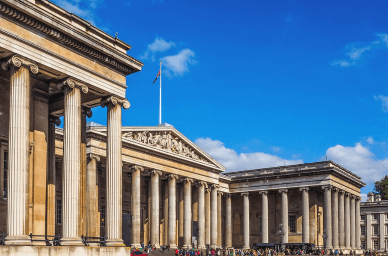Introduce part
The British Museum, also known as the British Museum, is one of the largest and most famous museums in the world. The museum has a collection of more than 7 million cultural relics and treasures from all over the world. The number and types of collections are rich, which is rarely seen in museums all over the world.
Rich collection of treasures
Because of its huge collection, the British Museum can almost display the history of civilization in the entire world. Although there is space limitation, about 50,000 collections can still be exhibited in the museum at the same time each time. The main collections come from the Middle Ages, especially the collections of ancient Egypt and ancient Greece and Rome, as well as a large number of precious cultural relics from Asia, the Middle East, Africa and America. Cultural treasures from many parts of the world can only be seen

The ancient Greek-style main
building imitates the ancient Greek-style architecture. The main entrance is a tall colonnade, with 8 thick and tall Roman columns on each side, and a gable roof decorated with reliefs. Entering the museum from the main entrance, you will arrive at the Great Court. The Great Court, which was inspired by the Louvre Pyramid, connects more than 100 large and small exhibition halls around it, which are transparent, bright and simple.
Bright Great Atrium The Great
Atrium was originally part of the British Library. After the library moved out, it was transformed into a covered square with a white tone. The huge translucent roof of the square is composed of many pieces of strangely shaped glass pieces, combined with white stone, even in the dark weather of London, it still has excellent lighting. The sculptures displayed in the atrium are real treasures, such as the marble lion and the Easter Island stone statue. In addition, artists from all over the world perform live here from time to time, adding a relaxed atmosphere to the serious museum.
In the center of the large atrium is the reading room, which displays art documents and books open to the public, where visitors can appreciate the dome and the quaint circular bookshelves up close. The names of famous people are marked at the entrance of the reading room to commemorate their reading here. Cafes and restaurants are set up on both sides and above the large atrium, which is convenient for dining while overlooking the entire atrium. There is a museum shop along the outside of the reading room, where you can also buy souvenirs after visiting.
Rosetta Stone (Rosetta Stone, exhibition hall 4 on the main floor) in the town hall
. This stone tablet originally belonged to Egypt, and there are three different text versions of the ancient Egyptian pharaoh’s edict engraved on it. According to the comparison of these texts, archaeologists gradually grasped the key to deciphering the ancient Egyptian civilization. The Rosetta Stone displayed in the Cairo Museum in Egypt is a replica.
The Admonitions Scroll, a total of 12 scrolls, 9 of which are Tang Dynasty copies in the British Museum. The portrait of female historians ranks 39th in the BBC’s “100 Cultural Relics of World History”, which shows the high cultural and historical value, and there are many collectors of the picture scrolls.
The Elgin Marbles (Hall 18) are remnants of the Parthenon. They have a history of more than 2,500 years, and have been purchased and moved to the museum by the British royal family for more than 200 years.
Featured pavilion
#Asia Pavilion#: Halls 33 and 95. Among them, 33 is the exhibition hall of China, South Asia, and Southeast Asia. In addition to Chinese cultural relics, there are also collections from India and other countries; 33B is the exhibition hall of Chinese jade, and 95 is the exhibition hall of Chinese ceramics.
The British Museum is a museum that collects a large number of lost cultural relics in China. It has more than 25,000 pieces and about 2,000 long-term exhibitions. Cultural relics; several famous kilns of porcelain are divided into different curation according to Ru, Ge, Jun, Ding, and Guan, and the professionalism is orderly. Recommended viewing cultural relics also include large-scale Tang Sancai, Cizhou Kiln “Circus Pillow” in Song Dynasty, blue and white fish and algae plate in Yuan Dynasty, Xuande cloisonne in Ming Dynasty, and Dunhuang mural Buddha statues.
#Ancient Egypt Pavilion#: Hall 4, 61-66. One of the most popular places in the museum. Among the exhibits are mummies. The Ancient Egypt Pavilion is also the most visited pavilion, and almost everyone who visits the British Museum must see the Egyptian Pavilion.
#Ancient Greece and Rome Pavilion#: Halls 11-23, 69-73, 77, 78, 82-85. The entire Parthenon is very shocking, and there are many ancient Greek marble sculptures and exquisite bottles and other cultural relics. The Portland Vase in Hall 70 is also not to be missed.
Some exhibits are not suitable for long-term exhibition, and they will only be displayed at certain times of the year (including the above-mentioned female history admonishment). If you are interested in visiting, you need to check the schedule on the official website in advance.opening hours Monday to Thursday, Saturday to Sunday 10:00-17:00 (last entry 16:00) and Friday 10:00-20:30 (last entry 19:30); the museum closes at 12 Closed from April 24th to 26th, the specific business status is subject to the opening of the dayService Facilities
Interpreter rental : The British Museum provides electronic audio guide rental, which can be reserved online or on-site at the service desk in the Great Atrium Working hours: 10:00-17:30 Fee: £7
Restaurant : There is a restaurant in the large atrium of the museum that provides lunch and afternoon tea, and there are also two cafes that provide a variety of sandwiches, snacks, salads, sweets, pasta and various beverages. There are mobile food carts at the entrance of the museum, selling hot drinks and some snacks.
